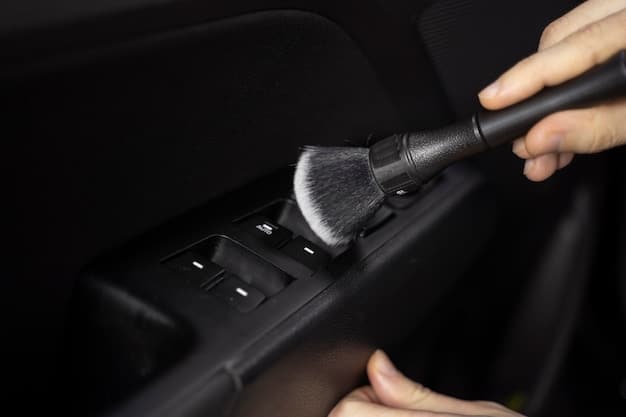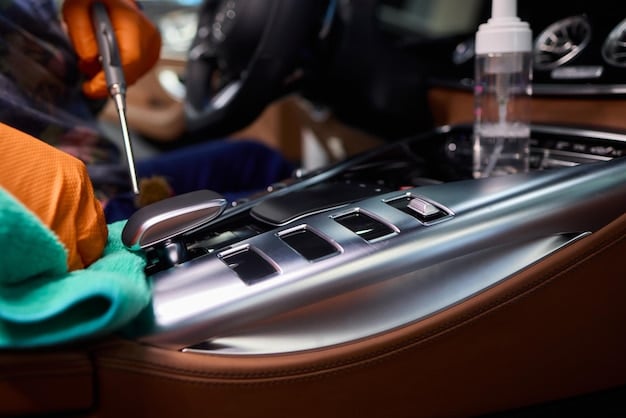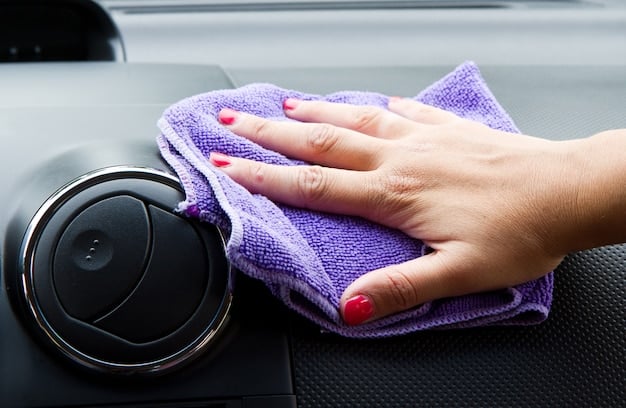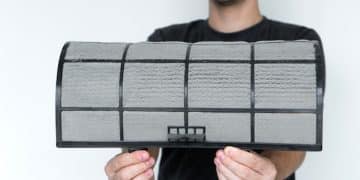Detailing Your Car’s Interior: Keep It Clean & Fresh

Detailing your car’s interior involves a comprehensive cleaning and restoration process to maintain its cleanliness and freshness, enhancing your driving experience and preserving the vehicle’s value.
Ready to make your car’s interior shine? Detailing your car’s interior: How to keep your car’s interior clean and fresh doesn’t have to be a chore. With the right techniques and products, you can transform your car into a comfortable and inviting space.
Why Detailing Your Car’s Interior Matters
Detailing your car’s interior is more than just a cosmetic procedure; it’s an essential part of car maintenance. A clean interior enhances your driving experience and can significantly impact the vehicle’s resale value.
Regular interior detailing is vital for maintaining hygiene and preventing the buildup of allergens, dust, and odors. Let’s explore why detailing is so important.
Health and Hygiene
A car’s interior can quickly become a breeding ground for bacteria and allergens. Regular detailing helps to eliminate these harmful substances, creating a healthier environment for you and your passengers.
Preserving Value
A well-maintained interior can significantly increase your car’s resale value. Potential buyers are more likely to be impressed by a clean and fresh interior, reflecting positively on the overall condition of the vehicle.

Detailing your car’s interior is an investment in your health, comfort, and the long-term value of your vehicle.
Essential Tools and Products for Interior Detailing
Before you start detailing your car’s interior, it’s important to gather the right tools and products. Using the appropriate equipment can make the job easier and more effective.
Here are some essential items you’ll need to achieve professional-quality results. Get your gear ready before diving in.
- Vacuum Cleaner: A powerful vacuum cleaner with various attachments is essential for removing loose dirt, debris, and pet hair from carpets, seats, and crevices.
- Detailing Brushes: Different sizes and types of brushes are needed for cleaning air vents, dashboards, and other hard-to-reach areas without causing damage.
- Microfiber Cloths: Soft, lint-free microfiber cloths are ideal for wiping surfaces, applying cleaning solutions, and buffing finishes.
- Interior Cleaning Solutions: Choose pH-balanced interior cleaners that are specifically designed for automotive use. These cleaners are effective at removing stains and grime without damaging the interior surfaces.
Investing in high-quality tools and products will ensure that you can effectively clean and protect your car’s interior.
Step-by-Step Guide to Detailing Your Car’s Interior
Now that you have the necessary tools and products, it’s time to start detailing your car’s interior. Follow these step-by-step instructions to achieve a clean and fresh interior.
Each step is crucial for a thorough cleaning, so take your time and pay attention to detail.
Step 1: Remove Loose Items and Trash
Before you start cleaning, remove all loose items, such as floor mats, seat covers, and personal belongings. Dispose of any trash and debris to create a clear workspace.
Step 2: Vacuum the Interior
Use a vacuum cleaner to thoroughly remove loose dirt, dust, and debris from the carpets, seats, and other surfaces. Pay special attention to crevices and hard-to-reach areas.
Step 3: Clean the Dashboard and Console
Spray a small amount of interior cleaner onto a microfiber cloth and gently wipe down the dashboard, console, and other plastic surfaces. Use detailing brushes to clean air vents and intricate areas.

Step 4: Clean the Upholstery
For fabric upholstery, use a fabric cleaner and a soft brush to gently scrub the seats and carpets. For leather upholstery, use a leather cleaner and conditioner to nourish and protect the material.
Step 5: Clean the Windows and Mirrors
Spray a glass cleaner onto a microfiber cloth and wipe down the interior windows and mirrors. Use a separate clean cloth to buff the surfaces to a streak-free shine.
By following these steps carefully, you can achieve a professionally detailed interior that looks and feels like new.
Dealing with Specific Interior Cleaning Challenges
Sometimes, detailing your car’s interior involves dealing with specific cleaning challenges, such as stubborn stains, unpleasant odors, and damaged surfaces.
Here are some tips and techniques for addressing these common issues.
- Stain Removal: Act quickly when dealing with stains. Use a stain remover specifically designed for the type of stain (e.g., coffee, grease, ink). Apply the remover, let it sit for a few minutes, and then blot it with a clean cloth.
- Odor Elimination: Remove the source of the odor, if possible. Use an odor eliminator spray or an enzymatic cleaner to neutralize lingering smells. Baking soda can also be used to absorb odors; sprinkle it on carpets and seats, let it sit overnight, and then vacuum it up.
- Surface Repair: For minor scratches on plastic surfaces, use a plastic polish to buff out the imperfections. For damaged upholstery, consider hiring a professional to repair or replace the material.
Addressing these challenges head-on will help you maintain a clean, fresh, and well-maintained car interior.
Maintaining Your Car’s Interior After Detailing
Once you’ve detailed your car’s interior, it’s important to maintain it to keep it looking its best. Regular maintenance can prevent the buildup of dirt, dust, and odors, saving you time and effort in the long run.
Here are some tips for keeping your car’s interior clean and fresh.
Regular Vacuuming
Vacuum your car’s interior at least once a month to remove loose dirt and debris. Pay special attention to high-traffic areas, such as the driver’s seat and floor mats.
Wipe Down Surfaces
Regularly wipe down the dashboard, console, and other surfaces with a microfiber cloth and a mild interior cleaner. This will prevent the buildup of dust and grime.
Use Floor Mats and Seat Covers
Protect your car’s carpets and seats by using floor mats and seat covers. These accessories can be easily removed and cleaned, helping to keep your interior in good condition.
By following these maintenance tips, you can keep your car’s interior looking clean and fresh for years to come.
Professional Detailing vs. DIY Detailing: Which Is Right for You?
When it comes to detailing your car’s interior, you have two options: professional detailing or DIY detailing. Both approaches have their pros and cons, and the best choice depends on your budget, time, and skill level.
Let’s compare professional detailing and DIY detailing to help you decide which is right for you.
Professional Detailing
Professional detailing involves hiring a professional detailing service to clean and restore your car’s interior. This option offers several benefits:
- Expertise and Experience: Professional detailers have the knowledge, skills, and equipment to achieve superior results.
- Time Savings: Hiring a professional saves you time and effort.
- Advanced Techniques: Professional detailers use advanced techniques and products to address specific cleaning challenges.
DIY Detailing
DIY detailing involves cleaning and restoring your car’s interior yourself. This option offers several benefits:
- Cost Savings: DIY detailing is less expensive than hiring a professional.
- Flexibility: You can detail your car’s interior on your own schedule.
- Personal Satisfaction: DIY detailing can be a rewarding and satisfying experience.
Ultimately, the choice between professional detailing and DIY detailing depends on your individual needs and preferences.
| Key Point 🔑 | Brief Description ✍️ |
|---|---|
| 🧹 Vacuum Regularly | Keep dirt and debris at bay by vacuuming your car’s interior frequently, focusing on carpets and seats. |
| 🛡️ Protect Surfaces | Use seat covers and floor mats to shield your car’s interior from wear, spills, and sun damage. |
| 🧼 Clean Spills Quickly | Address spills immediately to prevent stains and odors from setting into your car’s upholstery and carpets. |
| 💨 Air it Out | Ventilate your car regularly by opening windows to help eliminate odors and maintain a fresh interior atmosphere. |
Frequently Asked Questions
▼
Detailing your car’s interior every 3-6 months is generally recommended. However, if you frequently transport pets or children, or if you notice excessive dirt or odors, you may need to detail it more often.
▼
Use a rubber glove or a pet hair removal tool to gather pet hair from seats and carpets. Vacuum the interior thoroughly, using a crevice tool to reach tight spaces. A lint roller can also be effective for removing stubborn hairs.
▼
Regularly clean and condition your leather seats with products specifically designed for automotive leather. Park your car in the shade whenever possible to prevent the leather from drying out and cracking due to sun exposure.
▼
Remove the source of the odor, if possible. Use an odor eliminator spray or an enzymatic cleaner to neutralize lingering smells. Baking soda can also be used to absorb odors; sprinkle it on carpets and seats, let it sit overnight, and then vacuum it up.
▼
It’s generally not recommended to use household cleaners on your car’s interior, as they may be too harsh and can damage the materials. Use cleaners specifically designed for automotive use to ensure that you’re not causing any harm.
Conclusion
Keeping your car’s interior clean and fresh is a rewarding task that enhances both your driving experience and the vehicle’s value. By following these detailing tips and maintenance practices, you can enjoy a comfortable, hygienic, and inviting car interior.





